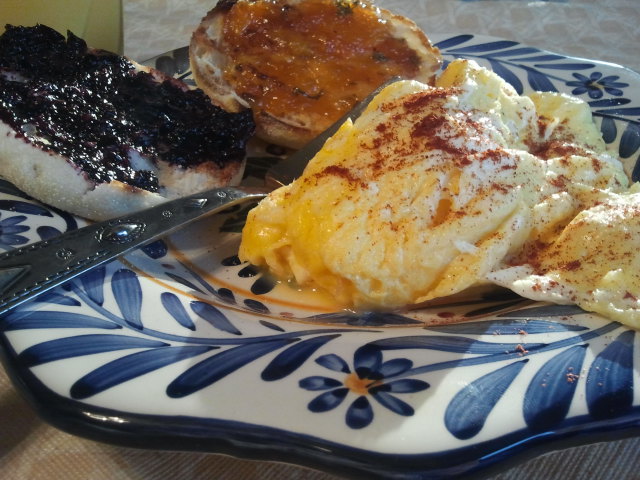Tips for Better Scrambled Eggs
I have a confession to make.
I’ve never made scrambled eggs well.
It’s not that they’ve been inedible or even half-bad. They’ve just never been really… good. They either end up doing an overcooked backstroke* around the plate or they wallpaper the pan. Both of these problems are somewhat alleviated by adding extras like sausage or cheese or peppers. But only in the way that putting a hat on fixes a bad hair day.
In the past few weeks however, my stars have unscrambled and a series of fortunate events have pushed better egg cookery upon me. These events are fairly mundane– a dirty pan, extra bacon grease, a distracted mama– but together they produced a breakfast that was anything but a jumbled up mess.
Tips for Better Scrambled Eggs:
- Use an appropriately sized pan. I’ve found it better to do single servings (2-4 eggs) in an 8 in pan rather than large batches in a 12 in pan. Using too big of pan seems to result in overcooked watery eggs, probably because they cook too fast to manipulate them properly.
- Use enough fat. Seriously. Even I, who have no fear of fat, evidently have not been using enough. Using at least 2 Tbs per serving seems to eliminate the eggy wallpaper problem. I know non-stick pans are supposed to be the Holy Ovum, I just don’t trust them. Even if you only use plastic utensils (an issue unto itself) they still get scratched. And where does all that stuff go? I shudder to think how much Teflon I’ve ingested. Besides, fat adds flavor. Butter is a natural companion to eggs, but I typically use bacon grease that I save in jar in the fridge. Frugal and tasty– what more can a cook ask for?
- Let the pan get hot enough before adding the eggs. This is another reason to forgo the non-stick pans as it’s dangerous to heat an empty Teflon pan. The beaten eggs should sizzle as you pour them into the pan and immediately begin to cook around the edges.
- Take them out of the pan before they are completely done. Eggs continue to cook after being removed from heat. So if you “go all the way” in the pan, you’ll be left with something less than the best on the plate. This step takes practice. After all, how to you know when they are “almost done” and not just undercooked? Only in the scrambling of many eggs will you learn, young eggdi, Yoda says. (Yes, I did just do that.)
- Cheese confuses this whole processes. It’s Meltiness sticks to the pan no matter how much fat you use. I suggest staying away from it until you get your Scramble on better. If you can’t do without it, try sprinkling it over the eggs on the plate rather than in the pan.
This list is far from exhaustive, I know. Some of your technique will depend on how you like your eggs. For example, I prefer a cohesive lump rather than a thousand tiny curds. So I tend to flip my eggs rather than break them up by stirring. What about all of you? How do you like your eggs? What techniques do you use to get the perfect Scramble?
*Eggs get watery when overcooked because the proteins have contracted too much and pushed all the liquid out. Therefore, cooking the eggs more will only exacerbate the problem.

